
NGC 4211, 13m5, 1.0', S0/a pec
NGC 4211A, 14m3, 1.5', S0/a pec
Distance: approx. 210 MLy
Coma Berenices
Uranometria: S. 178 (old), S. 72-left (new)
DSS II (5' x 5')
further information:
Messier45.com
not observed yet

NGC 7805, 13m2, 1.2' x 0.9', SAB0^0: pec
NGC 7806, 13m5, 1.1' x 0.8', SA(rs)bc? pec
Distance: approx. 220 MLy
Pegasus
Uranometria: S. 89 (old), S. 45-left (new)
DSS II (5' x 5')
further information:
Messier45.com
not observed yet

NGC 70, 13m4, 1.4' x 1.2', SA(rs)c III
Distance: approx. 330 MLy
Andromeda
Uranometria: S. 89 (old), S. 45-left (new)
DSS II (5' x 5')
further information:
Messier45.com
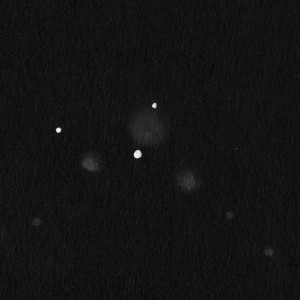
Uwe Glahn, 16", 230x, fst 6m3:
with 16" 9 galaxies visually detectable, Arp-trio with NGC 68, 70, 71, brightest galaxies of the group, NGC 68, 71 small, bright, NGC 70 large, diffuse, featureless round glow
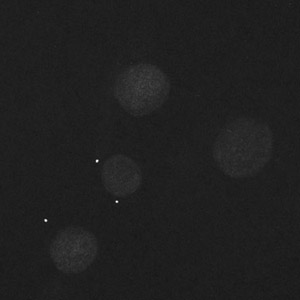
Martin Schoenball, 10", 197x, 6m6:
very faint, slightly brighter middle, round
Matthias Juchert, 8", fst 6m8:
At 50x together with NGC 71 and NGC 68 visible as a compact object. At 126x it is the brightest galaxy of the group. NGC 71 appears is very close and NGC 68 is a little more distant. NGC 70 is pretty faint but clearly visible and has a bright core. Confusingly it lies between two 13mag stars which stand within the halo.

NGC 2276, 11m3, 2.3' x 1.9', SBc
NGC 2300, 11m1, 2.8' x 2.0', SA0
Distance: approx. 90 MLy
Cepheus
Uranometria: S. 1 (old), S. 1-right/left (new)
DSS II (10' x 10')
further information:
Messier45.com
Uwe Glahn, 16", 189x, fst 6m6:
NGC 2300 smaller than NGC 2276 but brighter with bright nucleus, NGC 2276 totally diffuse without any nucleus
Martin Schoenball, 10", 100x, fst 5m3:
NGC 2276: very faint, small nebula, slightly brighter middle, little elongated
NGC 2300: clearly brighter than the neighbor NGC 2276 but still pretty faint, bright center with a faint stellar core, elongated about 3:2 E-W
Matthias Juchert, 8", fst 6m6:
Pretty bright, small galaxy already visible at 50x. It looks similar to a not resolved globular cluster and is very concentrated to the very bright center at 126x. Near the fainter NGC 2276.

Messier 60, 8m8, 7.5' x 6.1', E2
NGC 4647, 11m4, 2.9' x 2.3', SAB(rs)c
Distance: approx. 55 MLy
Virgo
Uranometria: S. 194 (old), S. 90-right (new)
DSS II (5' x 5')
further information:
Messier45.com

Martin Schoenball, 10", 139x, fst 5m6:
M 60: Very bright and round, very concentrated towards the middle with a small center and a nucleus. West preceding is the companion NGC 4647
NGC 4647: Faintly visible with direct vision. Elongated, close to M 60 in NE. Nice but not very easy double! Large brightness contrast!
Matthias Juchert, 2,5", fst 6m5:
Easy with direct vision, bright, large, round-oval, very bright center. NGC 4647 is visible with averted vision at the north western border of M 60.
Matthias Juchert, 8", fst 6m5:
Very bright, very large, distinct central area with a very bright core. The companion NGC 4647 is faintly visible with direct vision, and a clearly oval nebula with averted vision.

NGC 1141, 13m1, 0.9' x 0.7', SAB0-:pec/Rng
NGC 1142, 12m8, 0.9' x 0.5', Im pec/Ring B
Distance: approx. 400 MLy
Cetus
Uranometria: S. 220 (old), S. 119-left (new)
DSS II (5' x 5')
further information:
SDSS Image
Messier45.com
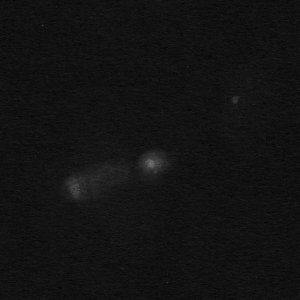
Uwe Glahn, 16", 360x, fst 6m3:
pair of bright galaxies, NGC 1141 round with bright core, NGC 1142 with offset nucleus attached at the eastern end, fainter body in direction to NGC 1141, PGC 1150350 third faint galaxy 1' NW

NGC 1888, 12m1, 3.0' x 0.8', Sb: pec sp
NGC 1889, 13m1, 0.7' x 0.5', SAB?(r:)0
Distance: approx. 110 MLy
Lepus
Uranometria: S. 270 (old), S. 136-right/137-left (new)
DSS II (5' x 5')
further information:
Messier45.com
Uwe Glahn, 16", fst 6m6:
NGC 1888 bright, elongated galaxy, bright companion NGC 1889 NE of the core of NGC 1888, only small space between both galaxies
Matthias Juchert, 8", fst 6m7:
Pretty bright and clearly visible at 98x. An oval-elliptic nebula with a faint center. Pretty large. Aborted the search for NGC 1889 due to extreme temperatures (-20°C!).

NGC 191, 13m4, 1.5' x 1.2', SAB(rs)C:pec
IC 1563, 14m0, 0.7' x 0.4', I 0
Distance: NGC 191 approx. 230 MLy, IC 1563 approx. 400 MLy
Cetus
Uranometria: S. 261 (old), S. 121-left/140-right (new)
DSS II (5' x 5')
further information:
SDSS Image
Messier45.com

Uwe Glahn, 16", 257x, fst 6m8:
beautiful trio of two galaxies and one faint star, NGC 191 round, diffus with bright core, IC 1563 only 40 SE, 1:3 SE-NW elongated, faint star near the W edge of the galaxy pair

NGC 1023, 9m5, 8.8' x 3.0', SB(rs)0-
Distance: approx. 30 MLy
Perseus
Uranometria: S. 62 (old), S. 61-left (new)
DSS II (10' x 10')
further information:
Messier45.com
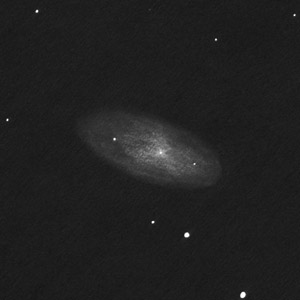
Martin Schoenball, 10", 139x, fst 7m0:
Very bright galaxy, highly elongated about 4:1, much brighter towards the middle with a stellar core, appearing longer towards east, one star superimposed in west and east

Uwe Glahn, 16", 225x, fst 6m5:
very bright and beautiful galaxy, 1:2 elongated brighter nucleus, whole galaxy
with a diffuse and very faint glow E-W, elongated 1:4, very faint companion NGC 1023A attached at the SE end, connected with the galaxy, 4 resolved stars in the glow of the galaxy

NGC 274, 11m8, 1.5', SAB(r:)0^0^ p
NGC 275, 12m5, 1.6' x 1.1', S pec
Distance: approx. 80 MLy
Cetus
Uranometria: S. 262 (old), S. 140-right (new)
DSS II (5' x 5')
further information:
Messier45.com
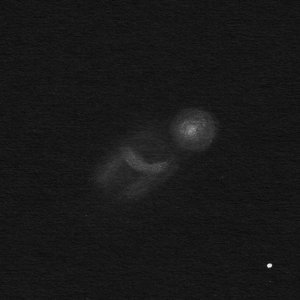
Uwe Glahn, 16", fst 7m1:
bright galaxy pair, brighter galaxy NGC 274 circular with slightly brighter nucleus, NGC 275 1:2 elongated SE-NW, with averted vision bean shaped core from NE to NW, SE faint dark wedge

UGC 3730, 13m4p, 2.8' x 1.5', Ring
UGC 3730, 16m9p?, Ring
Distance: approx. 120 MLy
Camelopardalis
Uranometria: S. 7 (old), S. 6-right/15-left (new)
DSS II (5' x 5')
further information:
Messier45.com
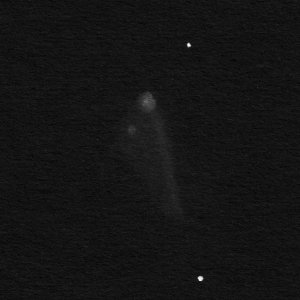
Uwe Glahn, 16", fst 6m5:
bright, round core in the N, to the S triangular faint nebula, brightest part in the W, SO of the bright core very faint and small condensation

NGC 2936, 12m9, 1.3' x 1.1', I, Ring B
NGC 2937, 13m6, 2.1' x 0.7', E, Ring A
UGC 5130, 13m4, E+SYS
Distance: approx. 320 MLy
Hydra
Uranometria: S. 233 (old), S. 113-left (new)
DSS II (5' x 5')
further information:
SDSS Image
Messier45.com

Uwe Glahn, 16", 320x, fst 6m4:
southern galaxy NGC 2937 small, bright and round glow, northern galaxy NGC 2936 bean shaped with the concave side NW, brightest part NE

NGC 2444, 12m9, 1.2' x 0.8', Ring A
NGC 2445, 12m9, 1.4' x 1.1', Ring B
Distance: approx. 180 MLy
Lynx
Uranometria: S. 101 (old), S. 57-right (new)
DSS II (5' x 5')
further information:
SDSS Image
Messier45.com

Uwe Glahn, 16", fst 6m5:
bright, round core in the N, to the S faint, conical shaped glow, two small spots of light in the E, southern spot a little brighter
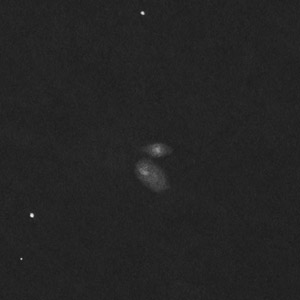
Martin Schoenball, 10", 91-179x, fst 6m5:
NGC 2444: Smaller of the two galaxies, but higher surface brightness. It is round and has an E-W elongated Halo. Both galaxies have no common halo.
NGC 2445: Larger of the two. It is a little brighter than NGC 2444 and much larger. Elongated 3:2 SW-NE. The galaxy brightens towards NE with a shifted core.